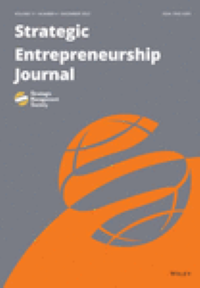The impact of customer ties and industry segment maturity on business model adaptation in an emerging industry
IF 5.4
2区 管理学
Q1 BUSINESS
引用次数: 11
Abstract
Research Summary: Why do some young firms change their business models while others do not? Why do some firms make small changes, while others make more substantial changes? And does industry context matter? Drawing on organizational learning theory and utilizing a unique data-base tracking 187 young firms through the first decade of the mobile health industry, we examine the role of customers in young firms' business model adaptation. We find a positive impact of customer portfolio breadth (capturing the number and diversity of customers) on both the likelihood and degree of business model change. Importantly, industry segment maturity moderates this relation: customer effects are strongest in the earliest, most uncertain stages. Our study provides a rare view into how a new industry and its young ventures co-evolve. Managerial Summary: Customers have been viewed as critical in a start-up venture's search for an initial business model, but their role in young firms' business model adaptation has not been examined. In this study, we show that a young firm's customer portfolio breadth is an important driver of business model change, especially at the earliest, most uncertain stages of an industry. Our results highlight the value of customers as sources of knowledge in emerging industries, and suggest that when making decisions about establishing and fostering customer ties, entrepreneurs should consider the number and diversity of those ties in the context of the maturity of the young firm's industry segment. the question of what leads some firms to experiment with their business models while others do not, and why some firms make small changes to their business models while others opt for more substantial ones. Our results show that broader (i.e., larger and more diverse) customer portfolios make business model change both more likely and more substantial. Further, these effects are negatively dependent variables. We further also control for alliance portfolio diversity . This variable measures the diversity of the firm's alliance portfolio, including R&D, outside investor, manufacturing, supply, and marketing ties. This control captures the potential diversity and breadth of knowledge brought forth by these alliance partners; we expect that it will have a positive impact on likelihood and degree of business model change. Alliance portfolio客户关系和行业细分成熟度对新兴行业商业模式适应的影响
研究综述:为什么一些年轻的公司改变了他们的商业模式,而另一些则没有?为什么有些公司会做出微小的改变,而另一些公司会做出更大的改变?行业背景重要吗?根据组织学习理论,并利用一个独特的数据库,在移动健康行业的第一个十年中跟踪187家年轻公司,我们研究了客户在年轻公司商业模式适应中的作用。我们发现,客户组合的广度(捕捉客户的数量和多样性)对商业模式变化的可能性和程度都有积极影响。重要的是,行业细分市场的成熟度调节了这种关系:客户效应在最早、最不确定的阶段最强。我们的研究为一个新行业及其年轻企业如何共同发展提供了一个罕见的视角。管理摘要:客户在初创企业寻找初始商业模式的过程中被视为至关重要的,但他们在年轻企业适应商业模式中的作用尚未得到检验。在这项研究中,我们表明,年轻公司的客户组合广度是商业模式变化的重要驱动力,尤其是在行业最早、最不确定的阶段。我们的研究结果强调了客户作为新兴行业知识来源的价值,并建议企业家在制定建立和培养客户关系的决策时,应在年轻公司细分行业成熟的背景下考虑这些关系的数量和多样性。是什么导致一些公司尝试他们的商业模式,而另一些公司则没有,以及为什么一些公司对他们的商业模型进行了小的改变,而其他公司则选择了更实质性的改变。我们的研究结果表明,更广泛(即更大、更多样化)的客户组合使商业模式更有可能发生变化,也更实质性。此外,这些影响是负的因变量。我们还进一步控制联盟投资组合的多样性。该变量衡量公司联盟投资组合的多样性,包括研发、外部投资者、制造、供应和营销关系。这种控制抓住了这些联盟伙伴带来的潜在多样性和知识广度;我们预计,这将对商业模式改变的可能性和程度产生积极影响。联盟投资组合
本文章由计算机程序翻译,如有差异,请以英文原文为准。
求助全文
约1分钟内获得全文
求助全文
来源期刊

Strategic Entrepreneurship Journal
Multiple-
CiteScore
11.10
自引率
1.60%
发文量
31
期刊介绍:
The Strategic Entrepreneurship Journal is a research journal that publishes original work recommended by a developmental, double-blind review process conducted by peer scholars. Strategic entrepreneurship involves innovation and subsequent changes which add value to society and which change societal life in ways which have significant, sustainable, and durable consequences. The SEJ is international in scope and acknowledges theory- and evidence-based research conducted and/or applied in all regions of the world. It is devoted to content and quality standards based on scientific method, relevant theory, tested or testable propositions, and appropriate data and evidence, all replicable by others, and all representing original contributions. The SEJ values contributions which lead to improved practice of managing organizations as they deal with the entrepreneurial process involving imagination, insight, invention, and innovation and the inevitable changes and transformations that result and benefit society.
 求助内容:
求助内容: 应助结果提醒方式:
应助结果提醒方式:


